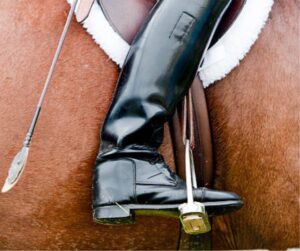Anettte Wilson | 0447337276
Anettte Wilson | 0447337276

The lower leg is a very difficult body part to train. It wobbles at all paces but can be trained to be stable and still at all paces.
The lower leg and exercises for the core are the key to good riding and the key to strong safe riding. However, horse riders are not taught HOW to keep the lower leg still. Horse riders are not taught HOW TO use their lower leg correctly. Many are just instructed to “use more lower leg”…well HOW?

Many horse riding instructors believe it is important to train the seat and concentrate on the seat only. Many believe that riders cannot move on until they achieve a deep independent seat. Many are recommending core exercises.
Sadly many horse riders find the task of gaining a deep seat to confronting and either give up or go from instructor to instructor. The way riders are taught doesn’t vary a great deal, though the stirrup length has a lot to do with the correct lower leg position. If it is too long the rider will balance on the reins, as in the photo.
I believe that training the lower leg in any and every rider is the first skill a rider needs to learn and improve on. It is vital to understand why, though. Humans use their hands and feet to keep their balance not their seat so when horse riding we do the same. To be able to balance through the lower leg first and feel the movement of the horse’s paces a rider can then move on to learn about balance through the seat. Core exercises and a strong core are essential.
To rise trot a rider’s weight is transferred from the seat to the stirrups, every beat. When the rider rises at the trot the weight is transferred from the seat to the stirrups, and the direction of the force is outward, hence, the rider’s legs flap or swing away from the horse’s side, at the rising trot. By learning how to control this movement a rider can then control the lower leg position. Core exercises and trunk control are important.
A deep independent seat can then be the next target.
When babies learn to walk they use their arms and hands for balance, riders do the same. A baby will use a couch or a table to balance on. The horse rider will use the reins and the horse’s mouth to balance. The other difference is the floor doesn’t move and a horse does. Learning to rise trot is a new skill for learners, so going back to basics makes it easy. Humans crouch for maximum stability so why not use this position to teach lower leg stability to the rider? This is explained in detail in the Applied Posture Riding Program
How To Ride A Horse.
I use the ball and exercises for the core to simulate the rising trot, when out of the saddle and I train riders to balance using special exercises in the saddle. As the lower leg becomes stronger and more stable the rider can let go of the neck for extra balance. This is an exercise I teach riders to do and practice. Once the balance has been established the hands can become useful not used for balance. Practicing this at the walk and the trot and once safe at the canter a rider will feel the amount of weight down through the heel. By training this and concentrating on keeping the leg close to the side of the horse balance will improve.

The position of the hands and trunk will develop as the lower leg becomes stable. When a rider starts to rise trot they lift their body and the weight moves from the saddle to the stirrups. If the stirrups go too low the trunk becomes more upright and stability can be compromised. I believe the trunk does tilt slightly forward in all riders at the rising trot because of this transfer of weight. The center of gravity is always moving hence the trunk will move from upright to tilt forward with the change in movement. I have a series of core exercises and specific movement patterns to train horse riders on how to ride and how to use their core properly, I train riders to ride. I am a rider coach.
If you are interested in training yourself to ride better, stronger, and more skilled then look at my Applied Posture Riding Membership Program.
For more of my self-designed products and programs have a look at my shop.
Follow me on Applied Posture Riding Facebook fill in the subscribe form and stay in touch.
Look Good Ride Well Dismiss